Boolean in C
In C, Boolean is a data type that contains two types of values, i.e., 0 and 1. Basically, the bool type value represents two types of behavior, either true or false. Here, '0' represents false value, while '1' represents true value.In C Boolean, '0' is stored as 0, and another integer is stored as 1. We do not require to use any header file to use the Boolean data type in c, but in C, we have to use the header file, i.e., stdbool.h. If we do not use the header file, then the program will not compile.
Boolean Data Type in C
In computer programming, Boolean data types play a fundamental role in representing and manipulating truth values, often denoted as "true" and "false." These types are named after the 19th-century mathematician and logician George Boole, whose work laid the foundation for modern digital logic. In C, a language known for its precision and low-level capabilities, the Boolean data type is not inherently built-in like integers or floats. Instead, it is often emulated using integral types, primarily int.Emulating Boolean Values
C does not have a dedicated Boolean data type in the same way that it has int or float. Instead, C programmers typically use integers (usually int or char) to represent Boolean values. In C, zero (0) represents "false," while any non-zero value represents "true." This means that you can use variables of type int to store Boolean values, like this:cint isTrue = 1; // Represents true
int isFalse = 0; // Represents falsem
In this example, isTrue is set to 1 to represent "true," and isFalse is set to 0 to represent "false." This convention allows C to work effectively with Boolean logic and comparisons.
Boolean Expressions and Operators
Logical Operators: C has three main logical operators for combining and manipulating Boolean values.
1. && (Logical AND): Returns true if both operands are true.
2. || (Logical OR): Returns true if at least one operand is true.
3. ! (Logical NOT): Returns the opposite of the operand's truth value.
Example:cint a = 1; int b = 0; int result = (a && b); // result is 0 (false)Relational Operators: These operators compare values and return Boolean results.
1. == (Equal): Returns true if two values are equal.
2. != (Not Equal): Returns true if two values are not equal.
3. >, <, >=, <=: Comparison operators for greater than, less than, greater than or equal to, and less than or equal to, respectively.
Example:cint x = 5; int y = 10; int isEqual = (x == y); // isEqual is 0 (false)Conditional Operator (
? :): Often called the "ternary operator," it is used to create conditional expressions.Example:
Boolean Variables and Data Structures
In C, Boolean variables are commonly used in conjunction with control structures to make decisions in a program. For instance, the if, else if, and else statements are used to conditionally execute code blocks based on Boolean expressions.
cint isRaining = 1;
if (isRaining) {
printf("Don't forget your umbrella!\n");
} else {
printf("Enjoy the sunny day!\n");
}In this example, the code inside the if block will execute because isRaining is true (1).Boolean Arrays and Bitwise Operators
In some cases, it's necessary to work with arrays of Boolean values, often represented as arrays of integers or as individual bits within an integer. Bitwise operators, such as & (bitwise AND), | (bitwise OR), and ^ (bitwise XOR), can be used to manipulate individual bits within integers to emulate Boolean arrays.Example of using bitwise operators:
cint flags = 0; // Initialize an integer to represent Boolean flags
// Set flags
flags |= (1 << 0); // Set the first flag (bit 0) to true
flags |= (1 << 2); // Set the third flag (bit 2) to true
// Check flags
int isFirstFlagSet = (flags & (1 << 0)) != 0; // Check if the first flag is set
int isSecondFlagSet = (flags & (1 << 1)) != 0; // Check if the second flag is setIn this example, Standard Library Support
While C itself does not provide a built-in Boolean data type, the C standard library (stdbool.h) introduced a bool data type, along with true and false constants, to enhance code readability and portability.c#include <stdbool.h>
bool isValid = true;bool isFinished = false; Using the stdbool.h library, you can write more expressive code with Boolean data types, improving the readability and maintainability of your C programs.Conclusion
In C programming, Boolean data types are essential for representing and manipulating truth values. While C does not have a dedicated Boolean data type, programmers often use integers to emulate Boolean values, with conventions where 0 represents "false," and non-zero values represent "true." Logical, relational, and conditional operators facilitate Boolean expressions and control structures. Additionally, libraries like stdbool.h provide standardized support for Boolean types, enhancing code clarity. Understanding Boolean data types and their usage is fundamental to writing effective C programs, especially when dealing with decision-making and conditional execution.
.png)

.png)
.png)
.png)

0 Comments